Paul Tapponnier, geologist, pioneer in the study of continental deformation and founder of the IPGP tectonics team in the early 1980s, died on December 24 in Beijing. His former colleagues and students pay tribute to him.
It is with great sadness that the IPGP and its former students and colleagues learned of the death of Paul Tapponnier in Beijing on December 24, 2023.

Paul Tapponnier, born January 6, 1947 in Annecy (France), was a pioneer in the study of continental deformation. Above all, he was an extraordinary field geologist who, armed with the most recent techniques, read the history of the Earth in landscapes and rocks and knew how to develop simple concepts to explain his observations. His pioneering use of satellite images led in the late 1970s to the publication of the first map of active faults across Central Asia showing large strike-slip faults that had previously gone unnoticed. These observations combined with a physical approach to deformations, with analog and more recently digital models, led him to propose a model where Tibet is expelled in two phases towards the East under the pressure of India, causing the opening of marginal basins. In close collaboration with Chinese, Nepalese and other country geologists, his work has made it possible to describe the surface ruptures of numerous ancient earthquakes and to quantify the speeds of numerous Quaternary faults in Tibet, the Himalayas, Afar, in North Africa, the Middle East, the Mediterranean and North America. He also worked on subductions and the source of tsunamis in the Antilles and Indonesia. He had this exceptional capacity to integrate the geological context of active deformations and therefore to understand very varied time scales. He supervised numerous thesis students who will remember his rigor, as well as his creativity. He was co-author of more than 370 publications, some of which marked the history of plate tectonics.
A civil engineer in the mines of Paris in 1970, he obtained a doctorate in science in 1978 at the University of Montpellier under the supervision of Maurice Mattauer and including a two-year stay with Peter Molnar at the Massachusetts Institute of Technology (1973-1975). He joined the Institute of Globe Physics in Paris in 1980 where he founded the Laboratory of Tectonics and Lithosphere Mechanics. He took part in the first Franco-Chinese geological explorations of Tibet, which would be followed by many other missions. From 2009, he worked at Nanyang Technological University in Singapore, and since 2019 at the National Institute of Natural Hazards in Beijing. He received numerous distinctions, both scientific and civil, including the CNRS silver medal (1984), the Alfred Wegener medal (European Geological Union, 1985), the grand scientific prize of the city of Paris in 1990, Fellow of American Geophysical Union (1994), Francis Birch Lecturer (American Geophysical Union, 1999), the Lyell Medal (Geological Society of London, 2001). He was a member of the Paris Academy of Sciences in the Universe Sciences section (2005, correspondent since 1994), of the American National Academy of Sciences (2005), honorary member of the Geological Society of London, (2008 ), Einstein Professor of the Chinese Academy of Sciences (2011), and honorary member of the Nepal Geological Society (2012). He was named a Chevalier of the Legion of Honor in 1996 and received the Friendship Award from the Chinese government in 1998.
Fluent in English and Italian, and with a good knowledge of Chinese, Paul was curious about all aspects of foreign cultures. He shared this passion with his wife, renowned photographer Kevin Kling, who participated in most of his field expeditions. Active until his death, his work initiated discussions that are still relevant today and are a source of inspiration for structural geologists around the world.
Nicolas Arnaud, Jean-Philippe Avouac, Lucilla Benedetti, Anne Briais, Marie-Luce Chevalier, Liqing Jiao, Liu Jing, Yann Klinger, Cécile Lasserre, P. Hervé Leloup, Haibing Li, Isabelle Manighetti, Gilles Peltzer, Anne Replumaz, Jérôme Van der Woerd, Xiwei Xu on behalf of all of these students and colleagues around the world.
 KEYFACT Energy
KEYFACT Energy